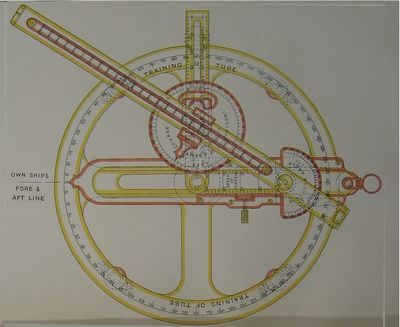Line of Sight Indicator

The Line of Sight Indicator was a British Torpedo Control instrument, very similar to a Torpedo Director Pattern 2006 conceived around 1915 and intended to be mounted on the bridge of a light cruiser or destroyer. The intent was to permit these values to be passed on for placing on the sight at the tube.
Design
It had a circular base plate fixed to indicate relative bearings from 0 to 180 degrees red and green. A torpedo bar graduated up to 48 knots could swing about to any bearing and be clamped by a screw. The enemy bar also pivoted at the center of the base and was graduated up to 40 knots. The sighting arm functioned as one would on a torpedo director, and a possible shot strip was clamped alongside.
A Robinson's Disc permitted enemy inclination to be read off, and a second disc shows the director angle from 0 to 90 degrees.[2] From the illustration, however, it does not seem that the director angle would be more accurately noted than within 2 degrees or so.
History
In March, 1914, it was decided to supply each of the Boadicea class (which may mean the entire scout cruiser series) with two of these for use with the Torpedo Director Pattern 2380s they'd be given in lieu of 2390As, but availability through Portsmouth of this material was not anticipated before mid-1914. A report on their use was requested.[3]
The device was designed by Vernon and manufactured by Portsmouth Royal Dockyard and was to be supplied to all light cruisers of Blonde class and later and destroyers of "F" class and later. The First Light Cruiser Squadron was not to receive these, as they already were noted as having similar devices.[4]
See Also
Footnotes
Bibliography
- H.M.S. Vernon. (Jan 1916) Annual Report of the Torpedo School, 1915. C.B. 1166. Copy 1025 at The National Archives. ADM 189/35.
- Admiralty, Gunnery Branch (1917). Handbook of Torpedo Control, 1916. C.B. 302. Copy No. 141 at The National Archives. ADM 186/381.